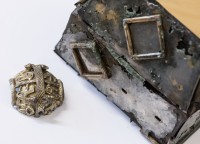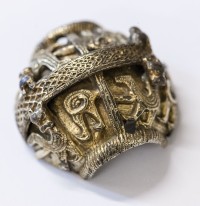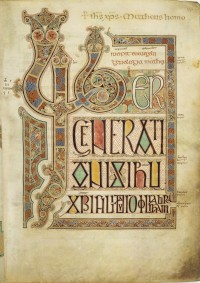 An Irish archaeologist has identified British early Christian artifacts in the collection of the University Museum of the Norwegian University of Science and Technology (NTNU). One is a part of a gold crozier that dates to the late 8th or early 9th century; the other is tin-plated wooden reliquary shaped like a church with kite-shaped metal fittings that once held gems or other decorations that have since fallen out. The crozier fragment and reliquary were discovered in 1961 in the grave of high status Viking woman in the central Norwegian town of Romsdal.
An Irish archaeologist has identified British early Christian artifacts in the collection of the University Museum of the Norwegian University of Science and Technology (NTNU). One is a part of a gold crozier that dates to the late 8th or early 9th century; the other is tin-plated wooden reliquary shaped like a church with kite-shaped metal fittings that once held gems or other decorations that have since fallen out. The crozier fragment and reliquary were discovered in 1961 in the grave of high status Viking woman in the central Norwegian town of Romsdal.
For the past year, Griffin Murray from the University College Cork has been researching Irish archaeological artifacts in Scandinavian collections, looking particularly for early Christian croziers that may have been pillaged by Viking raiders and recycled into jewelry and other objects worthy of being buried as grave goods. He initially thought the Romsdal crozier was Irish, but upon closer examination he found the decoration is characteristic of the north of England rather than Ireland.
 The backing of the crozier fragment is semi-cylindrical in shape, which means it adorned the middle of the staff. It was cut in half and converted into an adornment of some kind, perhaps a brooch, the fate of the Celtic disc from a Viking woman’s grave in Lilleberge, Norway, discovered in storage at the British Museum early this year. Its age makes the crozier piece highly significant.
The backing of the crozier fragment is semi-cylindrical in shape, which means it adorned the middle of the staff. It was cut in half and converted into an adornment of some kind, perhaps a brooch, the fate of the Celtic disc from a Viking woman’s grave in Lilleberge, Norway, discovered in storage at the British Museum early this year. Its age makes the crozier piece highly significant.
“The most striking aspect of this object is the era it comes from. This is the oldest known English fragment, and the only one that dates from before 1000. If the Norwegian Vikings had not stolen it, it would most probably have been lost,” Murray said of the University Museum’s little piece of history. […]
[NTNU curator Jon Anders] Risvaag believe that the Viking raids may have saved the museum’s piece of crozier, noting that most of the croziers that remained in the British Isles were melted down for other uses.
“In Norway and other Scandinavian countries, these artefacts were buried as grave goods, which is why the finest objects are usually found in gravesites,” he said. “This tradition appears to have saved one of the oldest croziers we know of today.”
 The Viking Age dawned with the 793 raid on the priory of Lindisfarne in Northumbria, the earliest known Viking raid on the west. The crozier was made around that same period in the general area, so it could conceivably have been loot from one of the earliest Viking incursions on the British Isles.
The Viking Age dawned with the 793 raid on the priory of Lindisfarne in Northumbria, the earliest known Viking raid on the west. The crozier was made around that same period in the general area, so it could conceivably have been loot from one of the earliest Viking incursions on the British Isles.
Here’s a contemporary reaction to the Lindisfarne raid from a letter written by Alcuin of York (pdf), a church deacon and scholar at the court of Charlemagne, to Ethelred, King of Northumbria:
Lo, it is nearly 350 years that we and our fathers have inhabited this most lovely land, and never before has such terror appeared in Britain as we have now suffered from a pagan race, nor was it thought that such an inroad from the sea could be made. Behold, the church of St Cuthbert spattered with the blood of the priests of God, despoiled of all its ornaments; a place more venerable than all in Britain is given as a prey to pagan peoples. And where first, after the departure of St Paulinus from York, the Christian religion in our race took its rise, there misery and calamity have begun. Who does not fear this? Who does not lament this as if his country were captured? Foxes pillage the chosen vine, the heritage of the Lord has been given to a people not his own; and where there was the praise of God, are now the games of the Gentiles; the holy festivity has been turned to mourning.
I wonder what Alcuin would make of the fact that the very despoliation of those ornaments ensured their survival.
“the church of St Cuthbert”: when I went to live in Edinburgh in the 60s I was entertained to find that the Co-operative grocers shops and dairies were called St Cuthbert’s. Now, displaying that fine taste in language that characterises the last few decades, they’re called “Scotmid”.
😆 Scotmid sounds like an insect repellent.
“If the Norwegian Vikings had not stolen it, it would most probably have been lost,” Murray said of the University Museum’s little piece of history.”
I’m sure that Mr. Murray and Mr. Anders are not endorsing crime.
I’m sure they aren’t. They may be appreciating the paradox that from destruction came preservation, however.
Any mention of the base metal that was overlain by the gold? Was it perhaps an impure silver?
No mention of it, I’m afraid.
“…are now the games of the Gentiles….” What does that mean? Was he calling the raiders Gentiles? I don’t understand his use of the word.
Dearieme is right. Alcuin was referencing a verse from the book of Amos (Chapter 8, Verse 10) when he said the holy festivity has been turned to mourning, and the whole passage preceding it is an analogy in which the Christians of Northumbria are the Jews and the Vikings are the Gentiles.
It was used to refer to pagans, I believe.
:yes:
This tradition continues. Mormons do the same thing. They consider them selves the true inheritors of the Jewish tradition, and refer to all other christians as “gentiles”. I kind of think that has happened a number of times in Euro-Christian history.
Judah (and hence Jew) had the etymology “belief”. So the believers are Jews, and all the other nations (gentes) are the Gentiles.